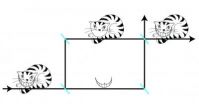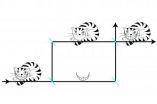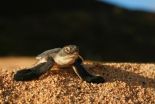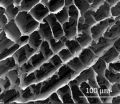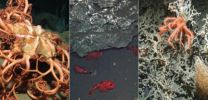(Press-News.org) The microbes living in the guts of males and females react differently to diet, even when the diets are identical, according to a study by scientists from The University of Texas at Austin and six other institutions published this week in the journal Nature Communications. These results suggest that therapies designed to improve human health and treat diseases through nutrition might need to be tailored for each sex.
The researchers studied the gut microbes in two species of fish and in mice, and also conducted an in-depth analysis of data that other researchers collected on humans. They found that in fish and humans diet affected the microbiota of males and females differently. In some cases, different species of microbes would dominate, while in others, the diversity of bacteria would be higher in one sex than the other.
These results suggest that any therapies designed to improve human health through diet should take into account whether the patient is male or female.
Only in recent years has science begun to completely appreciate the importance of the human microbiome, which consists of all the bacteria that live in and on people's bodies. There are hundreds or even thousands of species of microbes in the human digestive system alone, each varying in abundance.
Genetics and diet can affect the variety and number of these microbes in the human gut, which can in turn have a profound influence on human health. Obesity, diabetes, and inflammatory bowel disease have all been linked to low diversity of bacteria in the human gut.
One concept for treating such diseases is to manipulate the microbes within a person's gut through diet. The idea is gaining in popularity because dietary changes would make for a relatively cheap and simple treatment.
Much has to be learned about which species, or combination of microbial species, is best for human health. In order to accomplish this, research has to illuminate how these microbes react to various combinations of diet, genetics and environment. Unfortunately, to date most such studies only examine one factor at a time and do not take into account how these variables interact.
"Our study asks not just how diet influences the microbiome, but it splits the hosts into males and females and asks, do males show the same diet effects as females?" said Daniel Bolnick, professor in The University of Texas at Austin's College of Natural Sciences and lead author of the study.
While Bolnick's results identify that there is a significant difference in the gut microbiota for males and females, the dietary data used in the analysis are organized in complex clusters of disparate factors and do not easily translate into specific diet tips, such as eating more vegetables or less meat.
"To guide people's behavior, we need to know what microbes are desirable for people," said Bolnick. "Diet and sex do interact to influence the microbes, but we don't yet know what a desirable target for microbes is. Now we can go in with eyes open when we work on therapies for gut microbe problems, as many involve dietary changes. We can walk into those studies looking for something we weren't aware of before. All along we treated diet as if it works the same for men and women. Now we'll be approaching studies of therapies in a different way."
Why men and women would react differently to changes in diet is unclear, but there are a couple of possibilities. The hormones associated with each sex could potentially influence gut microbes, favoring one strain over another. Also, the sexes often differ in how their immune systems function, which could affect which microbes live and die in the microbiome.
One notable exception in Bolnick's results was in the mice. Although there was a tiny difference between male and female mice, for the most part the microbiota of each sex reacted to diet in the same manner. Because most dietary studies are conducted on mice, this result could have a huge effect on such research, and it raises questions about how well studies of gut microbes in lab mice can be generalized to other species, particularly humans.
"This means that most of the research that's being done on lab mice — we need to treat that with kid gloves," said Bolnick.
INFORMATION:
Bolnick's co-authors are Lisa Snowberg (UT Austin); Philipp Hirsch (University of Basel and Uppsala University); Christian Lauber and Rob Knight (University of Colorado, Boulder); Elin Org, Brian Parks and Aldons Lusis (University of California, Los Angeles); J. Gregory Caporaso (Northern Arizona University and Argonne National Laboratory); and Richard Svanbäck (Uppsala University).
This research was funded by the Howard Hughes Medical Institute, the David and Lucile Packard Foundation and the Swedish Research Council.
Diet affects men's and women's gut microbes differently
2014-07-29
ELSE PRESS RELEASES FROM THIS DATE:
Scientists separate a particle from its properties
2014-07-29
Researchers from the Vienna University of Technology have performed the first separation of a particle from one of its properties. The study, carried out at the Institute Laue-Langevin (ILL) and published in Nature Communications, showed that in an interferometer a neutron's magnetic moment could be measured independently of the neutron itself, thereby marking the first experimental observation of a new quantum paradox known as the 'Cheshire Cat'. The new technique, which can be applied to any property of any quantum object, could be used to remove disturbance and improve ...
The quantum Cheshire cat: Scientists separate a particle from its properties
2014-07-29
The Quantum Cheshire Cat: Can a particle be separated from its properties? On July 29, the prestigious journal, Nature Communications, published the results of the first Cheshire Cat experiment, separating a neutron from its magnetic field, conducted by Chapman University in Orange, CA, and Vienna University of Technology.
Chesire Cat"Well! I've often seen a cat without a grin," thought Alice in Wonderland, "but a grin without a cat! It's the most curious thing I ever saw in my life!" Alice's surprise stems from her experience that an object and its property cannot exist ...
The quantum Cheshire cat
2014-07-29
The Cheshire Cat featured in Lewis Caroll's novel "Alice in Wonderland" is a remarkable creature: it disappears, leaving its grin behind. Can an object be separated from its properties? It is possible in the quantum world. In an experiment, neutrons travel along a different path than one of their properties – their magnetic moment. This "Quantum Cheshire Cat" could be used to make high precision measurements less sensitive to external perturbations.
At Different Places at Once
According to the law of quantum physics, particles can be in different physical states at ...
Major turtle nesting beaches protected in 1 of the UK's far flung overseas territories
2014-07-29
But on the remote UK overseas territory of Ascension Island, one of the world's largest green turtle populations is undergoing something of a renaissance.
Writing in the journal Biodiversity and Conservation, scientists from the University of Exeter and Ascension Island Government Conservation Department report that the number of green turtles nesting at the remote South Atlantic outpost has increased by more than 500 per cent since records began in the 1970s. As many as 24,000 nests are now estimated to be laid on the Island's main beaches every year, making it the second ...
Could summer camp be the key to world peace?
2014-07-29
According to findings from a new study by University of Chicago Booth School of Business Professor Jane Risen, and Chicago Booth doctoral student Juliana Schroeder, it may at least be a start.
Risen and Schroeder conducted research on Seeds of Peace, one of the largest peacebuilding programs that brings together teenagers from conflict regions, including Israelis and Palestinians, every year for three weeks in rural Maine. They tracked participants' feelings and attitudes toward the other national group for three years with three separate cohorts of campers. They found ...
Tough foam from tiny sheets
2014-07-29
HOUSTON – (July 29, 2014) – Tough, ultralight foam of atom-thick sheets can be made to any size and shape through a chemical process invented at Rice University.
In microscopic images, the foam dubbed "GO-0.5BN" looks like a nanoscale building, with floors and walls that reinforce each other. The structure consists of a pair of two-dimensional materials: floors and walls of graphene oxide that self-assemble with the assistance of hexagonal boron nitride platelets.
The researchers say the foam could find use in structural components, as supercapacitor and battery electrodes ...
Research may explain how foremost anticancer 'guardian' protein learned to switch sides
2014-07-29
Cold Spring Harbor, NY -- Researchers at Cold Spring Harbor Laboratory (CSHL) have discovered a new function of the body's most important tumor-suppressing protein. Called p53, this protein has been called "the guardian of the genome." It normally comes to the fore when healthy cells sense damage to their DNA caused by stress, such as exposure to toxic chemicals or intense exposure to the sun's UV rays. If the damage is severe, p53 can cause a cell to commit preprogrammed cell-death, or apoptosis. Mutant versions of p53 that no longer perform this vital function, on the ...
Study: Pediatric preventive care guidelines need retooling for computerized format
2014-07-29
INDIANAPOLIS -- With the increasing use of electronic medical records and health information exchange, there is a growing demand for a computerized version of the preventive care guidelines pediatricians use across the United States. In a new study, researchers from the Indiana University School of Medicine and the Regenstrief Institute report that substantial work lies ahead to convert the American Academy of Pediatrics' Bright Future's guidelines into computerized prompts for physicians, but the payoff has the potential to significantly benefit patients from birth to ...
Menu secrets that can make you slim by design
2014-07-29
If you've ever ordered the wrong food at a restaurant, don't blame yourself; blame the menu. What you order may have less to do with what you want and more to do with a menu's layout and descriptions.
After analyzing 217 menus and the selections of over 300 diners, the Cornell study published this month in the International Journal of Hospitality Management showed that when it comes to what you order for dinner, two things matter most: what you see on the menu and how you imagine it will taste.
First, any food item that attracts attention (with bold, hightlighted or ...
From 'Finding Nemo' to minerals -- what riches lie in the deep sea?
2014-07-29
As fishing and the harvesting of metals, gas and oil have expanded deeper and deeper into the ocean, scientists are drawing attention to the services provided by the deep sea, the world's largest environment. "This is the time to discuss deep-sea stewardship before exploitation is too much farther underway," says lead-author Andrew Thurber. In a review published today in Biogeosciences, a journal of the European Geosciences Union (EGU), Thurber and colleagues summarise what this habitat provides to humans, and emphasise the need to protect it.
"The deep sea realm is so ...
